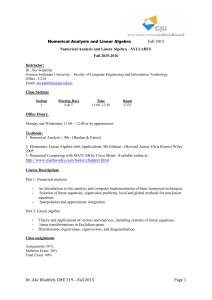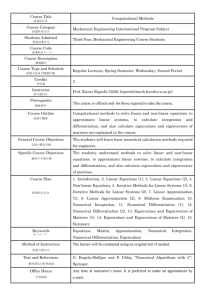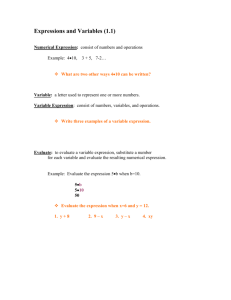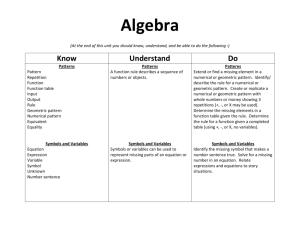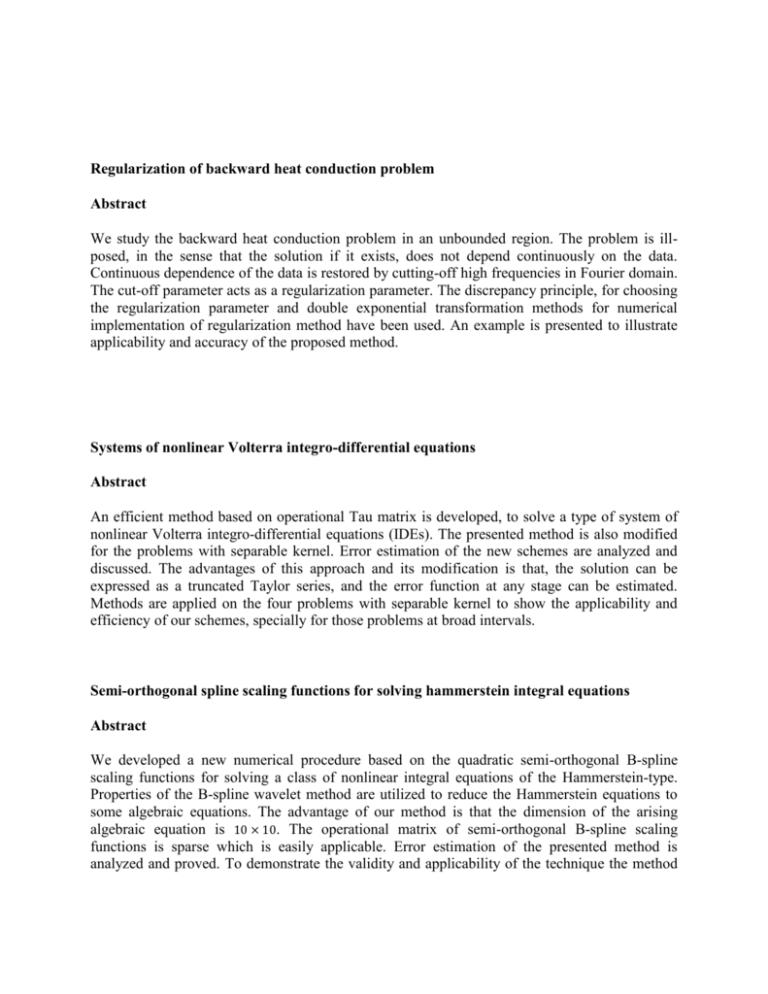
Regularization of backward heat conduction problem
Abstract
We study the backward heat conduction problem in an unbounded region. The problem is illposed, in the sense that the solution if it exists, does not depend continuously on the data.
Continuous dependence of the data is restored by cutting-off high frequencies in Fourier domain.
The cut-off parameter acts as a regularization parameter. The discrepancy principle, for choosing
the regularization parameter and double exponential transformation methods for numerical
implementation of regularization method have been used. An example is presented to illustrate
applicability and accuracy of the proposed method.
Systems of nonlinear Volterra integro-differential equations
Abstract
An efficient method based on operational Tau matrix is developed, to solve a type of system of
nonlinear Volterra integro-differential equations (IDEs). The presented method is also modified
for the problems with separable kernel. Error estimation of the new schemes are analyzed and
discussed. The advantages of this approach and its modification is that, the solution can be
expressed as a truncated Taylor series, and the error function at any stage can be estimated.
Methods are applied on the four problems with separable kernel to show the applicability and
efficiency of our schemes, specially for those problems at broad intervals.
Semi-orthogonal spline scaling functions for solving hammerstein integral equations
Abstract
We developed a new numerical procedure based on the quadratic semi-orthogonal B-spline
scaling functions for solving a class of nonlinear integral equations of the Hammerstein-type.
Properties of the B-spline wavelet method are utilized to reduce the Hammerstein equations to
some algebraic equations. The advantage of our method is that the dimension of the arising
algebraic equation is 10 × 10. The operational matrix of semi-orthogonal B-spline scaling
functions is sparse which is easily applicable. Error estimation of the presented method is
analyzed and proved. To demonstrate the validity and applicability of the technique the method
applied to some illustrative examples and the maximum absolute error in the solutions are
compared with the results in existing methods.
B-spline collocation for solution of two-point boundary value problems
Abstract
A numerical method based on B-spline is developed to solve the general nonlinear two-point
boundary value problems up to order 6. The standard formulation of sextic spline for the solution
of boundary value problems leads to non-optimal approximations. In order to derive higher
orders of accuracy, high order perturbations of the problem are generated and applied to
construct the numerical algorithm. The error analysis and convergence properties of the method
are studied via Green's function approach. O(ℎ6 ) global error estimates are obtained for
numerical solution of these classes of problems. Numerical results are given to illustrate the
efficiency of the proposed method. Results of numerical experiments verify the theoretical
behavior of the orders of convergence.
A collocation method for the solution of nonlinear one-dimensional parabolic equations
Abstract
In this paper, we develop a collocation method based on cubic B-spline to the solution of
nonlinear parabolic equation 𝜀𝑢𝑥𝑥 = 𝑎(𝑥, 𝑡)𝑢𝑡 + 𝜑(𝑥, 𝑡, 𝑢, 𝑢𝑥 ) subject to appropriate initial, and
Dirichlet boundary conditions, where ε > 0 is a small constant. We developed a new two-level
three-point scheme of order O(ℎ2 + 𝑘 2 ). The convergence analysis of the method is proved.
Numerical results are given to illustrate the efficiency of our method computationally.
Non polynomial spline solutions for special linear tenth-order boundary value problems
Abstract
Non-polynomial spline is used for solution of the tenth-order linear boundary value problems.
We obtained the classes of numerical methods for a specific choice of the parameters involved in
non-polynomial spline. The end conditions consistent with the boundary value problems are
derived. Truncation errors are given. A new approach convergence analysis of the presented
methods is discussed. Two examples are considered for the numerical illustration. However, it is
observed that our approach produce better numerical solutions in the sense that max |ei| is
minimum.
Tension spline solution of nonlinear sine-Gordon equation
Abstract
The sine-Gordon equation plays an important role in modern physics. By using spline function
approximation, two implicit finite difference schemes are developed for the numerical solution
of one-dimensional sine-Gordon equation. Stability analysis of the method has been given. It has
been shown that by choosing the parameters suitably, we can obtain two schemes of orders
O(𝑘 2 + 𝑘 2 ℎ2 + ℎ2 ) and O(𝑘 2 + 𝑘 2 ℎ2 + ℎ4 ). At the end, some numerical examples are provided
to demonstrate the effectiveness of the proposed schemes.
Convergence analysis of nonic-spline solutions for special nonlinear sixth-order boundary
value problems
Abstract
In this paper, we use nonic-spline polynomial method for the numerical solution of special
nonlinear sixth-order two-point boundary value problems. The main idea is to use the conditions
of continuity as discretization equations for the sixth-order boundary value problem. The end
conditions are derived for defined spline. A new approach for convergence analysis of the
presented method discussed. Some examples are solved to illustrate the applications of method,
and to compare the computed results with other existing known methods.
An O(ℎ6 ) numerical solution of general nonlinear fifth-order two point boundary value
problems
Abstract
A sixth-order numerical scheme is developed for general nonlinear fifth-order two point
boundary-value problems. The standard sextic spline for the solution of fifth order two point
boundary-value problems gives only O(ℎ2 ) accuracy and leads to non-optimal approximations.
In order to derive higher orders of accuracy, high order perturbations of the problem are
generated and applied to construct the numerical algorithm. O(ℎ6 ) global error estimates
obtained for these problems. The convergence properties of the method is studied. This scheme
has been applied to the system of nonlinear fifth order two-point boundary value problem too.
Numerical results are given to illustrate the efficiency of the proposed method computationally.
Results from the numerical experiments, verify the theoretical behavior of the orders of
convergence.
Sextic spline solution of variable coefficient fourth-order parabolic equations
Abstract
We report new three-level implicit methods of O(ℎ2 + 𝑘 4 ) and O(ℎ4 + 𝑘 4 ) for the numerical
solution of fourth-order non-homogeneous parabolic partial differential equation with variable
coefficients. We use sextic spline in space and finite difference in time directions. Sextic spline
function relations are derived by using off-step points. The linear stability of the presented
method is investigated. We solve test problems numerically to validate the derived methods.
Numerical comparison with other existence methods shows the superiority of our presented
scheme.
Spline solution of two point boundary value problems
Abstract
We use a non-polynomial spline function to smooth the approximate solution of the second order
boundary value problems. The classes of numerical methods of second and fourth order, for a
specific choice of the parameters involved in non-polynomial spline, have been developed.
Convergence analysis of the presented methods is discussed. By considering the maximum
absolute errors in the solution at grid points for different choices of step size, we conclude that
non-polynomial spline produces the accurate results in comparison with the B-spline Laplace,
and Decomposition methods.
Approximate solution of systems of Volterra integral equations with error analysis
Abstract
This paper describes a procedure for solving the system of linear Volterra integral equations by
means of the Sinc collocation method. A convergence and an error analysis are given; it is shown
1
that the Sinc solution produces an error of order O(exp(-c 𝑁 2 )), where c is a constant. This
approximation reduces the system of integral equations to an explicit system of algebraic
equations. The analytical results are illustrated with numerical examples that exhibit the
exponential convergence rate.
Quintic spline methods for the solution of singularly perturbed boundary-value problems
Abstract
We develop a class of methods for the numerical solution of singularly perturbed two-point
boundary-value problems. Using non-polynomial quintic spline in grid points we can obtain the
fourth-order method only. But we develop the quintic spline in off-step points to raise the order
of accuracy. Based on such spline, the purposed methods are fourth, sixth, and eighth-order
accurate. These methods are applicable to problems both in singular and non-singular cases. The
convergence analysis of the fourth-order method is stablished. Numerical results are given to
illustrate the efficiency of our methods.
Numerical solution of the nonlinear Klein-Gordon equation
Abstract
A numerical method is developed to solve the nonlinear one-dimensional Klein-Gordon equation
by using the cubic B-spline collocation method on the uniform mesh points. We solve the
problem for both Dirichlet and Neumann boundary conditions. The convergence and stability of
the method are proved. The method is applied on some test examples, and the numerical results
have been compared with the exact solutions. The L2, L∞ and Root-Mean-Square errors (RMS)
in the solutions show the efficiency of the method computationally.
Tension spline approach for the numerical solution of nonlinear Klein-Gordon equation
Abstract
The nonlinear Klein-Gordon equation describes a variety of physical phenomena such as
dislocations, ferroelectric and ferromagnetic domain walls, DNA dynamics, and Josephson
junctions. We derive approximate expressions for the dispersion relation of the nonlinear KleinGordon equation in the case of strong nonlinearities using a method based on the tension spline
function and finite difference approximations. The resulting spline difference schemes are
analyzed for local truncation error, stability and convergence. It has been shown that by suitably
choosing the parameters, we can obtain two schemes of O (𝑘 2 + 𝑘 2 ℎ2 + ℎ2 ) and O (𝑘 2 +
𝑘 2 ℎ2 + ℎ4 ). In the end, some numerical examples are provided to demonstrate the effectiveness
of the proposed schemes.
Spline approximate solution of eighth-order boundary-value problems
Abstract
We use non-polynomial spline functions to develop numerical methods for the solution of the
eighth-order linear boundary-value problems. End conditions of the spline are derived. We
compare our results with the results produced by decomposition method and polynomial spline
method. However, it is observed that our approach produce better numerical solutions in the
sense that 𝑚𝑎𝑥‖𝑒𝑖 ‖ is minimum.
Numerical methods based on non-polynomial sextic spline for solution of variable
coefficient fourth-order wave equations
Abstract
A new technique based on non-polynomial sextic spline functions connecting spline functions
values at mid knots and their corresponding values of the fourth-order derivatives is developed.
We derive various classes of three level implicit spline methods for solution of fourth-order nonhomogeneous parabolic partial differential equation with variable coefficient. These new
numerical methods are based on non-polynomial sextic spline in space and finite difference in
time directions. The linear stability of the presented methods is investigated. We solve test
problems numerically to validate the derived methods. Numerical comparison with other existing
methods shows the superiority of our presented scheme.
Convergence analysis of spline solution of certain two-point boundary value problems
Abstract
The smooth approximate solution of second order boundary value problems are developed by
using non-polynomial quintic spline function. We obtained the classes of numerical methods,
which are second, fourth and six-order. For a specific choice of the parameters involved in a non-
polynomial spline, truncation errors are given. A new approach convergence analysis of the
presented methods are discussed. Three test examples are considered in our references. By
considering the maximum absolute errors in the solution at grid points and tabulated in tables for
different choices of step size, we conclude that our presented methods produce accurate results in
comparison with those obtained by existing methods.
Quintic spline solution of boundary value problems in the plate deflection theory
Abstract
In this paper, Quintic spline in off-step points is used for the solution of fourth-order boundary
value problems. Spline relations and boundary formulas are developed and the convergence
analysis of the given method is investigated. Numerical illustrations are given to show the
applicability and efficiency of our method.
Non-polynomial cubic spline methods for the solution of parabolic equations
Abstract
Second-order parabolic partial differential equations are solved by using a new three level
method based on non-polynomial cubic spline in the space direction and finite difference in the
time direction. Stability analysis of the method has been carried out and we have shown that our
method is unconditionally stable. It has been shown that by suitably choosing the parameters
most of the previous known methods for homogeneous and non-homogeneous cases can be
obtained from our method. We also obtain a new high accuracy scheme of O(ℎ4 + 𝑘 4 ).
Numerical examples are given to illustrate the applicability and efficiency of the new method.
Spline solution of non-linear singular boundary value problems
Abstract
A class of non-linear singular boundary value problems is solved by new methods based on nonpolynomial cubic spline. We use the quasilinearization technique to reduce the given non-linear
problem to a sequence of linear problems. We modify the resulting set of differential equations at
the singular point then treat this set of boundary value problems by using a non-polynomial cubic
spline approximation. Convergence of the methods is shown through standard convergence
analysis. Numerical examples are given to illustrate the applicability and efficiency of our
methods.
Non-polynomial spline for solution of boundary-value problems in plate deflection theory
Abstract
In this paper a non-polynomial quintic spline function is applied to the numerical solution of a
certain fourth-order, two-point boundary-value problem occurring in plate deflection theory.
Direct methods of orders two, four, and six have been obtained which lead to five-diagonal linear
systems. Boundary formulae of various orders have been developed to retain the bandwidth of
the coefficient matrix as five. Convergence analysis of the sixth-order method is given.
Numerical results are provided to demonstrate the superiority of our methods.
Convergence of approximate solution of system of Fredholm integral equations
Abstract
In this paper numerical solution of system of linear Fredholm integral equations by means of the
Sinc-collocation method is considered. This approximation reduces the system of integral
equations to an explicit system of algebraic equations. The exponential convergence rate of the
method O(𝑒 −𝑘√𝑁 ) is proved. The method is applied to a few test examples with continuous
kernels to illustrate the accuracy and the implementation of the method.
Solution of a Volterra integral equation by the Sinc-collocation method
Abstract
In this paper a collocation procedure is developed for a linear Volterra integral equation of the
second kind by using the Sinc basis functions. The approximate solutions are given so that the
auxiliary basis functions satisfy the four different end conditions. It is shown that the Sinc
procedure converges to the solution at an exponential rate of O(𝑒 −𝑘√𝑁 ). Numerical results are
included to confirm the efficiency and accuracy of the method.
Convergence of cubic-spline approach to the solution of a system of boundary-value
problems
Abstract
We use cubic spline to derive some consistency relations which are then used to develop a
numerical method for the solution of a system of fourth-order boundary-value problems
associated with obstacle, unilateral, and contact problems. It is known that a class of variational
inequalities related to contact problems in elastostatics can be characterized by a sequence of
variational inequations, which are solved using some numerical method. Boundary formula of
order O (ℎ8 ) are formulated. The most common approach for convergence analysis are using
monotonicity of the coefficient matrix. But here we study a new approach and give the
convergence of prescribed method, so that the matrix associated with the system of linear
equations that arises, is not required to be monotone. Numerical examples are given to show the
applicability and efficiency of our method.
Spline approximate solution of fifth-order boundary-value problem
Abstract
We use non-polynomial spline function to develop numerical methods for the solution of the
fifth-order linear boundary-value problems. End conditions of the spline are derived. We
compare our results with the results produced by other decomposition method, Local polynomial
regression and spline methods. However, it is observed that our approach produce better
numerical solutions in the same that max||𝑒𝑖 || is a minimum.
Cubic spline solution of singularly perturbed boundary value problems with significant
first derivatives
Abstract
We develop a numerical technique for a class of singularly perturbed two-point singular
boundary value problems on an uniform mesh using polynomial cubic spline. The scheme
derived in this paper is second-order accurate. The resulting linear system of equations has been
solved by using a tri-diagonal solver. Numerical results are provided to illustrate the proposed
method and to compared with the methods in [R.K. Mohanty, Urvashi Arora, A family of nonuniform mesh tension spline methods for singularly perturbed two-point singular boundary value
problems with significant first derivatives, Appl. Math. Comput., 172 (2006) 531-544; M.K.
Kadalbajoo, V.K. Aggarwal, Fitted mesh B-spline method for solving a class of singular
singularly perturbed boundary value problems, Int. J. Comput. Math. 82 (2005) 67-76].
Spline methods for the solutions of hyperbolic equations
Abstract
Second-order hyperbolic equations with mixed boundary conditions are solved, by using a nonpolynomial cubic spline in space and finite difference in time direction. We develop new classes
of three level methods. Stability analysis of the methods have been carried out. It has been shown
that by suitably choosing the cubic spline parameters most of the previous known methods for
homogeneous and non-homogeneous cases can be derived from our methods. We also obtain
new high accuracy schemes of O (ℎ2 + 𝑘 2 ) and O (ℎ4 + 𝑘 2 ). Numerical example is given to
illustrate the applicability and efficiency of the new methods.
Spline approach to the solution of a singularly-perturbed boundary-value problems
Abstract
In this article, using spline in compression we develop the class of methods for the numerical
solution of singularly perturbed two-point boundary-value problems. The purposed methods are
second-order and fourth-order accurate and applicable to problems both in singular and nonsingular cases. Convergence analysis of the methods are discussed and numerical results are
given to illustrate the efficiency of our methods.
Non-polynomial spline methods for the solution of a system of obstacle problems
Abstract
We use a non-polynomial quintic spline functions to develop numerical methods for the solution
of system of second-order boundary-value problems associated with obstacle, unilateral, and
contact problems. We show that the approximate solutions obtained by the present methods are
better than those produced by other collocation, finite difference and spline methods. A
numerical example is given to illustrate practical usefulness of our methods.
The numerical solution of integro-differential equation by means of the Sinc method
Abstract
We develop a numerical procedure for solving a class of linear integro-differential equation of
Fredholm type, using the globally defined Sinc basis functions. Properties of the Sinc procedure
are utilized to reduce the computation of the linear integro-differential equation to some
algebraic equations. We used three numerical examples to illustrate the accuracy and to show the
implementation of our method.
Parametric spline method for a class of singular two-point boundary value problems
Abstract
We develop a three-point formula based on cubic spline in compression, for a class of singular
two-point boundary value problems. For different values of parameters we obtain the classes of
methods. These methods are illustrated by three numerical examples, two linear and one nonlinear.
Comment on the paper "A class of methods based on non-polynomial spline functions for
the solution of a special fourth-order boundary-value problems with engineering
applications"
Abstract
Comment on the paper "A class of methods based on non-polynomial spline functions for the
solution of a special fourth-order boundary-value problems with engineering applications" in
Applied Mathematics and Computation 174 (2006) 1169-1180. The paper considered a class of
𝑑4 𝑦
two-point boundary-value problems of the form 𝑑𝑥 4 + f (x) y = g (x), a ≤ x ≤ b,(2) y (a) =𝐴1 , y
(b) = 𝐴2 , y′ (a) = 𝐵1, y′ (b) = 𝐵2,where f(x) and g(x) are continuous on [a, b], and 𝐴𝑖 and 𝐵𝑖 (i = 1,
2) are finite real constants. Here we correct some mistake in derivation of non-polynomial spline,
boundary formulas, truncation errors, convergence analysis and computational experiments.
New approach for numerical solution of Hammerstein integral equations
Abstract
In this paper, we use a numerical procedure for solving a class of nonlinear integral equations of
the Hammerstein-type, using the globally defined Sinc basis functions. Properties of the Sinc
procedure are utilized to reduce the computation of the Hammerstein equations to some algebraic
equations. We used some numerical examples to illustrate the accuracy and the implementation
of the method.
The numerical solution of non-linear singular boundary value problems arising in
physiology
Abstract
A class of non-linear singular ordinary differential equations, is solved by a new method based
on non-polynomial cubic spline. We use the quesilinearization technique to reduce the given
non-linear problem to a sequence of linear problems. We modify the resulting set of differential
equations at the singular point then treat this set of boundary value problems by using nonpolynomial cubic spline approximation. The resulting system of algebraic equations is solved by
using a tri-diagonal solver. Computational results are provided to demonstrate the viability of the
new method.
Convergence of numerical solution of a fourth-order boundary value problem
Abstract
Quintic spline procedure for the solution of a fourth-order boundary value problem is developed,
spline relations are derived, boundary condition formula of orders O(ℎ6 ) and O(ℎ8 ) are
formulated. The convergence of prescribed method is proved, the matrix associated with the
system of linear equations that arises is not required to be monotone, the only requirement is that
𝑓(𝑥) be positive. Numerical illustration are given.
Numerical solution of linear integral equations by using Sinc-collocation method
Abstract
A collocation procedure is developed for linear Fredholm integral equations of the second kind,
using Sinc basis functions. The convergence rate of the method is O(𝑒 −𝑘 𝑀 ). Numerical results
are included to confirm the efficiency and accuracy of the method. © 2004 Elsevier Inc. All
rights reserved.
Spline methods for the solution of fourth-order parabolic partial differential equations
Abstract
In this paper a fourth-order non-homogeneous parabolic partial differential equation, that
governs the behaviour of a vibrating beam, is solved by using a new three level method based on
parametric quintic spline in space and finite difference discretization in time. Stability analysis of
the method has been carried out. It has been shown that by suitably choosing the parameters
most of the previous known methods for homogeneous and non-homogeneous cases can be
derived from our method. We also obtain two new high accuracy schemes of O(𝑘 4 , ℎ6 ) and
O(𝑘 4 ,ℎ8 ) and two new schemes which are analogues of Jain's formula for the non-homogeneous
case. Comparison of our results with those of some known methods show the superiority of the
present approach.


